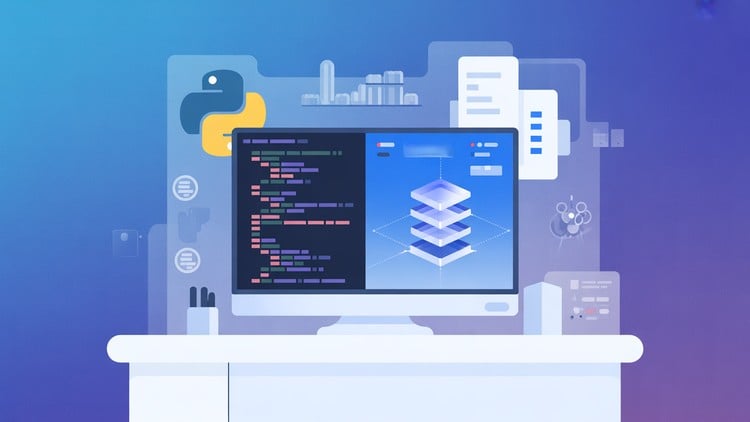
Learn Dask arrays, dataframes & streaming with scikit-learn integration, real-time dashboards etc.
⏱️ Length: 2.9 total hours
⭐ 4.70/5 rating
👥 6,663 students
🔄 August 2025 update
Add-On Information:
Note➛ Make sure your 𝐔𝐝𝐞𝐦𝐲 cart has only this course you're going to enroll it now, Remove all other courses from the 𝐔𝐝𝐞𝐦𝐲 cart before Enrolling!
-
Course Overview
-
- This essential course provides a deep dive into Dask, Python’s versatile library for parallel computing, enabling data scientists and engineers to conquer big data challenges that overwhelm traditional in-memory processing.
- Uncover the core principles that allow Dask to distribute computations across multiple cores or machines, transforming complex tasks into scalable, manageable operations.
- Grasp how Dask seamlessly integrates with the established Python scientific computing stack, extending the reach of familiar tools like NumPy and Pandas to petabyte-scale datasets.
- Understand the intelligent architecture behind Dask’s lazy evaluation and dynamic task graph optimization, critical for constructing highly efficient and robust parallel applications.
- Gain practical insights into optimizing resource utilization and managing Dask deployments across diverse environments, from local setups to enterprise cloud infrastructure.
- Position yourself at the forefront of scalable data processing, equipped to deliver timely insights from ever-growing data volumes in scientific, financial, and analytical domains.
- Learn to identify and strategically resolve common performance bottlenecks encountered when processing large datasets with conventional Python scripts.
- Cultivate a strategic mindset for designing inherently scalable and resilient data architectures that proactively address future data growth and complexity.
-
Requirements / Prerequisites
-
- A solid foundation in Python programming, including basic data structures, control flow, functions, and object-oriented concepts.
- Working familiarity with fundamental data science libraries, specifically NumPy and Pandas, and their core data manipulation functionalities.
- Basic understanding of data analysis concepts and experience with tabular data will enhance learning.
- Comfort with command-line interface usage and standard Python package management (e.g., pip, conda).
- An eagerness to explore distributed systems and scale data processing capabilities beyond single-machine limitations.
-
Skills Covered / Tools Used
-
- Proficiency in applying various distributed computing paradigms offered by Dask to different data types and problem sets.
- Expertise in discerning optimal use cases for Dask, distinguishing tasks that truly benefit from parallelization versus those that do not.
- Practical command over Dask’s diverse schedulers (e.g., threaded, multiprocessing, distributed) and their appropriate application contexts.
- Advanced techniques for manipulating out-of-core datasets using Dask’s parallel extensions of Pandas DataFrames and NumPy arrays.
- Strategic approaches to optimizing Dask computations through efficient task graph construction, memory management, and data partitioning.
- Skills in integrating Dask into existing analytical pipelines, progressively enhancing scalability without requiring complete workflow overhauls.
- Competence in leveraging Dask’s rich diagnostic tools and real-time dashboards for monitoring performance, debugging, and pinpointing distributed bottlenecks.
- A deep understanding of lazy evaluation principles and their impact on resource efficiency in large-scale data processing.
- Practical experience configuring and managing Dask clusters across diverse computing environments, from development machines to cloud-based systems.
- Ability to interpret and respond effectively to complex performance metrics provided by Dask’s monitoring interfaces.
- Developing robust, fault-tolerant parallel processing solutions capable of gracefully handling unexpected data anomalies or system interruptions.
- Strategic application of data locality principles to minimize data transfer overhead and maximize throughput in distributed environments.
- Effective communication of complex parallel computing strategies to technical and non-technical stakeholders.
-
Benefits / Outcomes
-
- Significantly boost your data processing efficiency, tackling much larger datasets in a fraction of the time, overcoming typical memory limitations.
- Elevate your professional standing as a data scientist or engineer, acquiring highly sought-after expertise in scalable data engineering and distributed machine learning.
- Gain the architectural confidence to design and implement robust solutions for enterprise-level big data challenges, moving beyond theoretical examples.
- Become an invaluable asset to any data-driven organization, capable of extracting insights from previously unmanageable datasets.
- Future-proof your data science skill set by aligning with the rapidly growing industry demand for parallel and distributed computing capabilities.
- Contribute to more cost-effective and timely data processing within your projects, optimizing computational resource allocation.
- Unlock new frontiers in research and development by accelerating experimentation cycles on massive datasets and enabling more sophisticated model exploration.
- Transform your capacity to deliver impactful business intelligence derived from vast, complex data sources.
- Successfully bridge the critical gap between small-data prototypes and high-performance, production-grade distributed systems.
-
PROS
-
- Highly practical and directly applicable curriculum addressing real-world scaling challenges in data science.
- Builds upon familiar Python data science tools (NumPy, Pandas), minimizing the learning curve for core users.
- Empowers learners to process exceptionally large datasets without requiring immediate access to specialized hardware.
- Develops a versatile skill set applicable across a wide array of industries, from finance to scientific research and beyond.
- Enhances critical understanding of system performance and optimization, essential for efficient modern data pipelines.
- Provides a clear, actionable pathway for deploying scalable solutions in various production environments.
- Directly resolves the frequent pain points of out-of-memory errors and sluggish computations common in data science.
-
CONS
-
- Mastery of Dask, like any advanced parallel computing framework, necessitates dedicated practice and a willingness to engage with complex conceptual challenges.
Learning Tracks: English,Development,Programming Languages
Found It Free? Share It Fast!